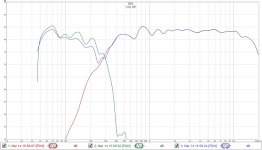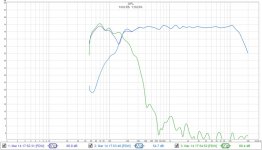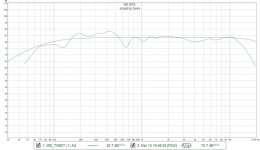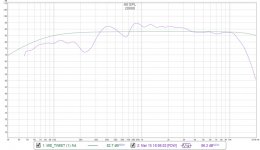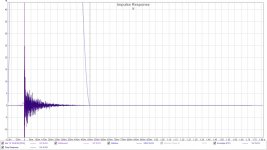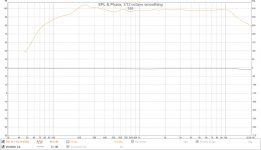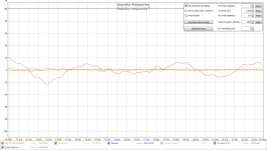Good points but you probably very busy yourself and haven't noticed pages back that mid tweeter dictated XO point upped to 160Hz, below is where he acoustic is now @LR4 that when time aligned will be electric transferred to BW4 and BS2 slopes.

Thanks Byrtt - you are right I missed the 160Hz XO requirement post.
Mkane, not throwing rocks but admire your energy and enthusiasm. It’s good practice and in some ways takes some flailing to get success when new. But don’t give up. Slow and steady good approach - just follow Byrtt’s Advice and overlays. You need to EQ down that slot loaded bass overshoot peak. Remember with EQ to use broad strokes, filter cuts tonsmoothbanpeak, never boost dips for EQ. Ok to boost shallow slope shelf.
measurements are implemented manually, on the output side of Mini DSP?You would know if you put the target curve in REW plot window and adjusted the measured via EQ and filter combo until they match. That’s the only way to do it if you are not familiar with what a BW4 and BS2 “Looks like by feel”. Until they match the textbook curves you are going to flail without success. So please slow down and try to implement a textbook overlay plot. It’s a must because your curves are way way off. They look like BW4 and BW4 so will naturally cancel with a deep notch when same polarity.
Use the REW EQ tab to implement the correct filters and then upload curves to miniDSP. Read up on that functionality. You can do it with 2-5 measurements with the proper technique.
And please move up away from 100Hz XO. That’s a bad spot from distortion standpoint and time delay standpoint. Try 350Hz. Move lower once you know how to do it. You can’t get BS2 on Eikona at 100Hz because it has natural falloff that will not allow you to implant a BS2 falloff.
Thanks Byrtt - you are right I missed the 160Hz XO requirement post.
Mkane, not throwing rocks but admire your energy and enthusiasm. It’s good practice and in some ways takes some flailing to get success when new. But don’t give up. Slow and steady good approach - just follow Byrtt’s Advice and overlays. You need to EQ down that slot loaded bass overshoot peak. Remember with EQ to use broad strokes, filter cuts tonsmoothbanpeak, never boost dips for EQ. Ok to boost shallow slope shelf.
Flailing for the most part yes. I'll keep at it
From memory (have not done this in over a year). Take manual raw (no EQ) measurement. Then click on EQ tab and play with predicted PEQ (parametric EQ) to match imported textbook curves. One they match, choose miniDSP and click export PEQ. Load PEQ into miniDSP. Take new measurement and see if it matches predicted curve.
Nope, this is the result of a REW sweep of the left and right channel simultaneously at the listening spot after DSP correction.
There wouldn't be a whole lot of difference if I took a minimum phase version of the impulse. For all practical purposes it would look almost identical.
This would not have been possible without damping panels, but you guys, measuring up close should mind the reflections you get. To get the crossover right you have to keep the reflections out of the measured signal.
Place speaker in the middle of the room, same for the microphone, remove clutter around it and use 6 cycles of frequency dependent windows. If needed, place something absorbent between the mic and speaker position on the floor. You have to avoid the reflections to get a useful crossover.
I see way too many peaks and dips in these graphs...
That's because I am measuring at the listening spot with both speakers running. I did measure at 80cm once to try, but the result sitting at the listening spot was not so great.
This time around, I tried to do it all with speakers at their place, and mic at the couch, ear level. It sounded better than anything else I tried.
That means that yes, room is taken into account with this. And speakers are tailored to this room only.
We must remember, that when we measure at listening spot, we record lots of reflected and even reverberating sound in the room, because of long gating time needed to see bass at all. This is very troublesome when setting subwoofer or low bass xo integration.
I have been fiighting with this issue with minidsp for 3 years... It takes time to understand what is actually happening, how it looks like in measurements and how it sounds. I have many times started from zero or twisted settigs way off from ideal to start with. My excuse is also that I use only UMIK-1 and REW. I prefer acoustic LR2 xo. Sometimes LR4 is the best you can get... I don't use bass reflex or TL cabinets, my subs are clossed box type.
My recommended procedure for indoor measurements is as follows: (always measure only left or right speaker+(sub)woofer)
1. measure sub and main separately in nearfield (1") with say 60ms IR right window gating and no smoothing --> you will see what comes out from the driver, low end roll-off
2. measure main and bass separately, with speaker in the middle of the room on a kitchen ladder (elevated) and mic on stand at 3'(1m) distance. Use various IR gatings to find out where reflection first nulls appear. With 20ms or longer gating you will see baffle step (or dipole loss) effects and bumps and null caused by reflections.
3. based on measurements of stage 2. set PEQ to straighten spl response at least one preferably two octaves past the desired xo frequency. Match spl levels too. No need to look at phase.
4. put sub and main speakers side-by-side on the floor in the middle of the room and place mic at 2' (60cm). Now we start to set xo and timing! We have basically straight output from bot units (but we see floor gain and reflections in the measurement) and when we set xo frequency and type in dsp, we really get what we ask for! Use delay settings to find out good timing between units. It they use different amps (subwoofer usually has a plate amp) timing can be way off from 0. If you don't drive both through same dsp unit, you are in trouble! We might even have different phase cycle for units ( at 100Hz one cycle is 10ms Frequency formula period time frequency cycle per second hertz Hz amplitude duration periodic time period to angular frequency formulary wavelength acoustic equation relationship wavelength Hz millisecond ms calculation calculate calculator t=1/f Hz )
4. When we get desired result from step 3, put speaker units at normal postions in the room. If their relative distance to listener (z-axis) changes, timing changes too) Now we star measuring at listening spot and long gatin. Use only low Q parametric eq and level settings of non-splitted signal (input) to equalize room gain etc. effects!
This is the way to get belly-kicking kick-drum and tight, solid bass notes from eg. double bass solos! Enjoy!
I have been fiighting with this issue with minidsp for 3 years... It takes time to understand what is actually happening, how it looks like in measurements and how it sounds. I have many times started from zero or twisted settigs way off from ideal to start with. My excuse is also that I use only UMIK-1 and REW. I prefer acoustic LR2 xo. Sometimes LR4 is the best you can get... I don't use bass reflex or TL cabinets, my subs are clossed box type.
My recommended procedure for indoor measurements is as follows: (always measure only left or right speaker+(sub)woofer)
1. measure sub and main separately in nearfield (1") with say 60ms IR right window gating and no smoothing --> you will see what comes out from the driver, low end roll-off
2. measure main and bass separately, with speaker in the middle of the room on a kitchen ladder (elevated) and mic on stand at 3'(1m) distance. Use various IR gatings to find out where reflection first nulls appear. With 20ms or longer gating you will see baffle step (or dipole loss) effects and bumps and null caused by reflections.
3. based on measurements of stage 2. set PEQ to straighten spl response at least one preferably two octaves past the desired xo frequency. Match spl levels too. No need to look at phase.
4. put sub and main speakers side-by-side on the floor in the middle of the room and place mic at 2' (60cm). Now we start to set xo and timing! We have basically straight output from bot units (but we see floor gain and reflections in the measurement) and when we set xo frequency and type in dsp, we really get what we ask for! Use delay settings to find out good timing between units. It they use different amps (subwoofer usually has a plate amp) timing can be way off from 0. If you don't drive both through same dsp unit, you are in trouble! We might even have different phase cycle for units ( at 100Hz one cycle is 10ms Frequency formula period time frequency cycle per second hertz Hz amplitude duration periodic time period to angular frequency formulary wavelength acoustic equation relationship wavelength Hz millisecond ms calculation calculate calculator t=1/f Hz )
4. When we get desired result from step 3, put speaker units at normal postions in the room. If their relative distance to listener (z-axis) changes, timing changes too) Now we star measuring at listening spot and long gatin. Use only low Q parametric eq and level settings of non-splitted signal (input) to equalize room gain etc. effects!
This is the way to get belly-kicking kick-drum and tight, solid bass notes from eg. double bass solos! Enjoy!
Last edited:
@perceval, what would make sense to me creating a good Harsch crossover is to create the crossover with measurements taken at closer distances to keep reflections out.
After checking their crossover sum at listening distance (with speakers in their desired position) you could use a room curve trough global EQ and do minor corrections based on averaging of measurements around the listening position.
I see Juhazi beat me to it and is saying more or less similar things. Contrary to his advise I would use 6 cycle FDW to look at the FR data, even at close range measurements, to get the crossover right and straighten out those crossover slopes. Believe me, I do have reasons for that. Lots of those reasons are written down in my enormous thread 🙂.
For the tonal balance, the EQ at the listening spot, you'd need longer windows with smoothing and in a non treated room I'd definitely use multiple measurements and average them within the most recent REW version(s) (keeps phase info for the average). It is important to align all IR's before averaging them.
After checking their crossover sum at listening distance (with speakers in their desired position) you could use a room curve trough global EQ and do minor corrections based on averaging of measurements around the listening position.
I see Juhazi beat me to it and is saying more or less similar things. Contrary to his advise I would use 6 cycle FDW to look at the FR data, even at close range measurements, to get the crossover right and straighten out those crossover slopes. Believe me, I do have reasons for that. Lots of those reasons are written down in my enormous thread 🙂.
For the tonal balance, the EQ at the listening spot, you'd need longer windows with smoothing and in a non treated room I'd definitely use multiple measurements and average them within the most recent REW version(s) (keeps phase info for the average). It is important to align all IR's before averaging them.
Last edited:
Last edited:
You can't boost a null, your IR probably shows a reflection causing the dip.
You can pump in any amount of boost you'd like, all that does is raise distortion.
Look at a distortion graph with the measurement without boost at that dip and with.
You'll see the distortion rise. It's better to figure out what the cause is of that reflection, and cure that for the crossover process, it doesn't have to be anything permanent.
Look at it like this, speaker is putting out 80 dB SPL, the reflection eats 20 dB from that, due to it's phase being opposite of the speaker signal, right there at the microphone. Now raise the SPL level by 5 dB, all that does is raise the reflected level by 5 dB as well. You may see it creep up just a little bit, but no where near as fast as the level of boost you apply. And at a slightly different spot, just a bit closer or further away you will have a peak because the reflection will have moved. Again, this is the primary reason to avoid reflections in these crossover measurements.
You can pump in any amount of boost you'd like, all that does is raise distortion.
Look at a distortion graph with the measurement without boost at that dip and with.
You'll see the distortion rise. It's better to figure out what the cause is of that reflection, and cure that for the crossover process, it doesn't have to be anything permanent.
Look at it like this, speaker is putting out 80 dB SPL, the reflection eats 20 dB from that, due to it's phase being opposite of the speaker signal, right there at the microphone. Now raise the SPL level by 5 dB, all that does is raise the reflected level by 5 dB as well. You may see it creep up just a little bit, but no where near as fast as the level of boost you apply. And at a slightly different spot, just a bit closer or further away you will have a peak because the reflection will have moved. Again, this is the primary reason to avoid reflections in these crossover measurements.
Last edited:
Thanks. That's exactly what happens. Boost just raises the entire dip. this measure is taken on Fr driver only, no x overinvolved. Beem messing with Eq all day and it's darn hard to figure what needs what without affecting something else. All good after a few whiskeys though.
Remember me linking this from your miniDSP thread? Why Can't I Fix All my Acoustic Problems with EQ?
Put a blanket or some big cushions between the speaker and the microphone, does anything change? Look around the speaker, get rid of everything that stands close to it.
Do the same around the microphone, observe the changes.
You can see it in the IR, if you zoom in on the first ~ 15 ms. You should see a single clear peak with that fullrange, some wiggles directly after that maybe (depending on the driver) but it should look reasonably clean after that, every peak after that big one has a cause. The bigger the peak (or a cluster of little peaks) the more it will eat away from the FR curve you want.
To get a great crossover, you shouldn't have any big peaks after that main one. And big being relative. If you select the [v] STEP as well on the IR graph in REW, you'll see a sudden change of direction there as well. That's your room and everything in it.
Do the same around the microphone, observe the changes.
You can see it in the IR, if you zoom in on the first ~ 15 ms. You should see a single clear peak with that fullrange, some wiggles directly after that maybe (depending on the driver) but it should look reasonably clean after that, every peak after that big one has a cause. The bigger the peak (or a cluster of little peaks) the more it will eat away from the FR curve you want.
To get a great crossover, you shouldn't have any big peaks after that main one. And big being relative. If you select the [v] STEP as well on the IR graph in REW, you'll see a sudden change of direction there as well. That's your room and everything in it.
Last edited:
I do and I'll go over it again, this time with a fine tooth comb. I've got to finish making dinner for my wife. Hope it rains all day again tomorrow thanks again.Remember me linking this from your miniDSP thread? Why Can't I Fix All my Acoustic Problems with EQ?
ir ...................................
Look at the time scale on the bottom, see how it starts in ms? Now zoom in so you get that first peak, and have the scale on the bottom display out to 15 ms. Right now we see all of it, we only want to look at the start.
You can click on the controls (upper right button) and have it set to: Plot responses normalised. Next to that there's a limits button, there you can set the scale you want to display.
Set Left s to -0,002 and right s to 0,015, if you have normalised active set % top to 110,0 and % bottom to -110,0 (for now) and press Apply Settings.
have the speaker surrounded with absorption panels
Not too bad, do you still have PEQ's active here? See how the dip between 100-200 Hz moved? We'll get there... no hurry.
Last edited:
- Home
- Loudspeakers
- Multi-Way
- S. Harsch XO
